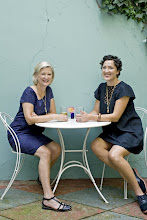 here
here is the article found in the chicago tribune that recently devastated me. i mean sobbing, hiding in my room, snotty nosed, think my life is over, i'm such a hypocrite, packing up, kind of upset.
how was i so blind?
when did this happen?
how fast can i close up shop, without having to move back in with my mom in wisconsin?
and then what would i do? how can i have no impact?
i don't know.
to oversimplify, the article says the growing global demand for cashmere (cheap) is causing over grazing in china/mongolia which leads to
desertification which causes, dust storms, which attached to urban air pollution to create uber pollution "clouds" that make their way,
all the way to seattle and cause serious air quality health issues globally. blood on my hands?
BUT here is why i went into cashmere.
personally:
1) i love it. its snuggly, warm, light, soft, luxurious, and forgiving.
2) i wanted a cashmere "wife beater". (there i go again, total hypocrite. but you know exactly what i am talking about.) my favorite,
long, simple silhouette but, in a fabrication that is socially versatile in a multitude of social settings.
3) i had developed a relationship with a really cool manufacturer, not a "garmento", willing to produce for little old me and who i continue to have candid, honest conversations about fair labor practices. this is a fete in and of itself. my industry is not know for its people of character.
4) asian textile quotas were removed and i knew the price of cashmere would be a bit more accessible.
personally/environmentally:
5) it lasts, its timeless. i was and am currently wearing cashmere that was my grandmothers. i know for a fact that beautiful, grey, knit, cashmere scarf i wear everyday is from the 1960's.
6) cashmere is usually (should be) an investment, a piece for "the collection". (ie my well edited closet relatively void of trendy, disposable garments not worth investing in due to their short lifespan and unoriginal presence). that, much like a good pair of jean(s) acts as the foundation for which my wardrobe stands. for me, that's great value.
environmentally:
7) the cashmere goats have (or had :() it pretty darn good. it is in the best interest of the shepherds to keep these goats healthy and happy.
7 1/2) "goats which are properly kept and combed should not tweak the conscience of all but the most extreme animal protectionist (who will suggest a petroleum-based alternative for equal warmth and breathability, which has its own drawbacks)"(
treehugger.com, christine lepisto)
8) no need for pesticides. and it doesn't take someone very long to hear me get up on the soapbox about conventional cotton/pesticide/herbicide use/big agribusiness. i'll save that for later, but if interested now, check out the
pesticide action network, or the
sustainable cotton project. be floored by the truth behind "the fabric of our lives".
9) it can be hand washed and laid flat to dry. no need for dry cleaning (chemicals, energy) or dryers (co2 emissions).
but here's the catch.
i wasn't the only person who knew cashmere was so cool.
walmart, the gap, saks, target, costco, etc. all caught on and decided to make cashmere as available as the cotton t-shirt. as the tribune article illustrates (albeit a bit alarmist in my opinion, but i could just be trying to make myself feel better) this is not without serious consequence.
which brings me to consumer habits, primarily over consumption.
i want to know which came first? our insatiable desire to shop/consume OR big box retail and the fancy marketing that tell us this is what we are on earth to do, consume. have more, better, cooler stuff than our neighbors?
the more we consume, the more we demand lower prices, ie more disposable items to keep up with our consumer habits.
but what do we end up with? the same shit as everyone else, credit card debt and a poisoned planet.
but the thing is, cashmere sweaters are not meant to be $19.99 as created by the "push pricing" practices of retail giants like walmart. its not sustainable. cashmere is the product of an ancient herding tradition and a limited resource to be protected.
so this is what i have decided for me and the future of uluru.
i am doing my best. i am really rather insignificant. i will stay informed. i will continue to do my best by pursuing (aka begging mills to sell little old me) eco-friendly yarns and fabrics, work with worker owned coops, require "fair labor" manufacturing, work local when possible, find ways to minimize plastic packaging, used recycled products in the office, ride my bike to work, write a book about "the collection" theory etc. etc. etc.
"bird by bird" as anne lamott would say.






